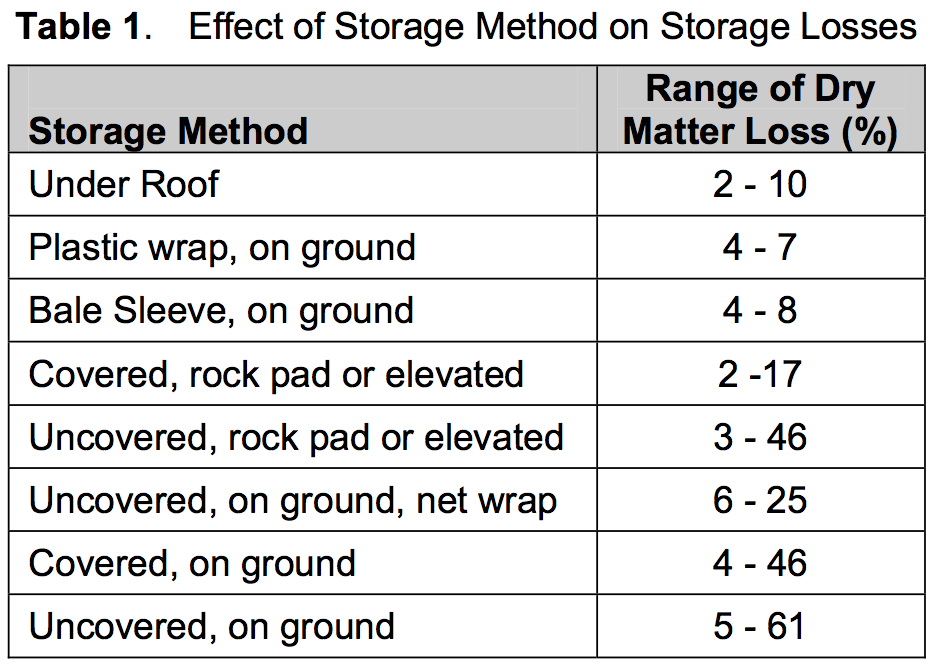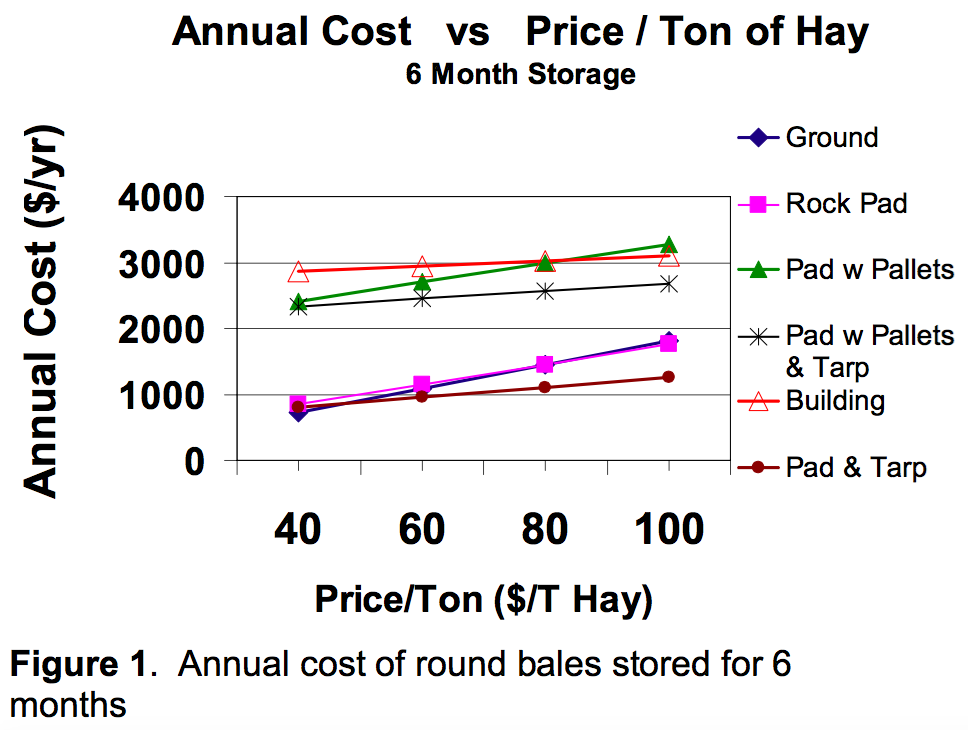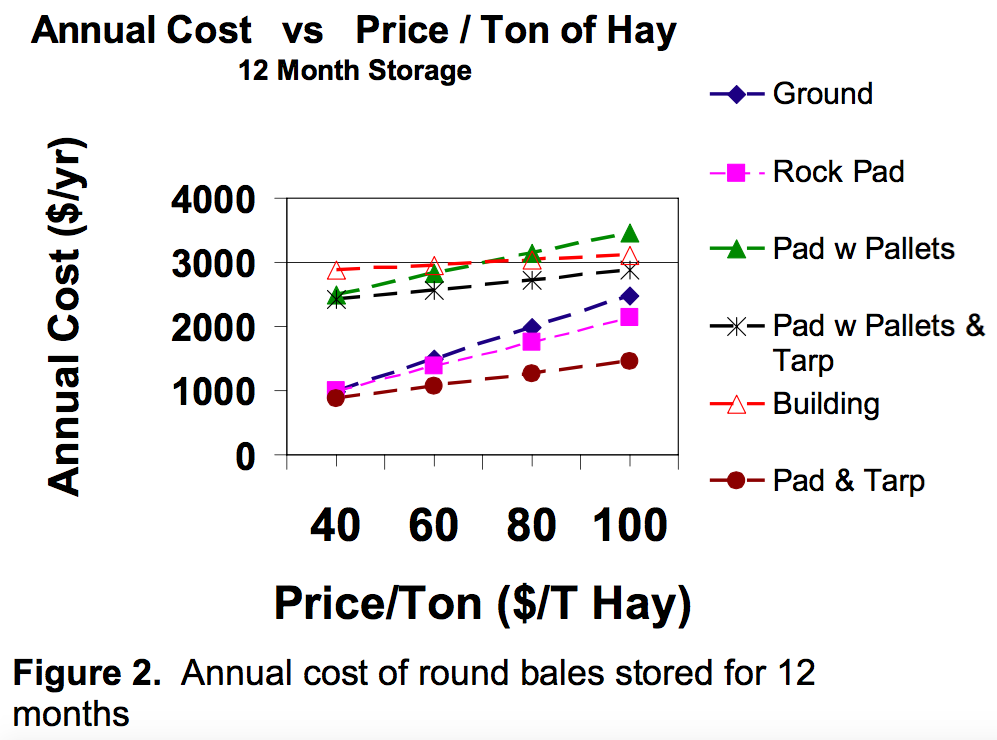Big Bale Storage Losses; how different options stack up
by Craig Saxe
Introduction
When harvesting baled hay, it’s not always easy to control weather related losses, but storage loses should be more controllable. After all, a lot of time, energy and expense have gone into producing a high quality and high value baled product. Many would argue correctly that expensive storage options aren’t necessary, but make sure to consider all your expenses.
Storage losses have a big effect on hay quantities and quality, so in the long run investing additional resources (money, labor, equipment) in hay storage could pay big dividends. To put storage losses in perspective, lets assume you store your hay outside and have a fairly reasonable storage loss of 10 percent. That may not sound all that bad, but a 10 percent storage loss means that for every 10 bales of hay that you harvest, you really only have the equivalent of 9 bales of hay to feed.
What are my bale storage options?
Storage options vary, but typical choices may include:
- Under roof
- Outside uncovered on the ground or elevated
- Outside covered on the ground or elevated
- Bale sleeve on the ground
- Plastic wrap on the ground
How does dry matter loss compare between storage options?
First it’s worth noting that if dry matter loss was the only factor to consider, hay storage under a roof would be an easy top choice. Table 1 gives general dry matter losses shared in multiple Extension bulletins and publications. The wide range in dry matter loss emphasizes the variability found between  individual trials and handling procedures in both dry and humid climates. Ultimately, dry matter loss is a function of hay moisture, temperature, and the length of time hay is exposed to these conditions. Large losses can occur in a short time frame under high moisture and temperature conditions. However, you can end up with similar losses by storing a dry product in a cool barn for an extended period of time.
individual trials and handling procedures in both dry and humid climates. Ultimately, dry matter loss is a function of hay moisture, temperature, and the length of time hay is exposed to these conditions. Large losses can occur in a short time frame under high moisture and temperature conditions. However, you can end up with similar losses by storing a dry product in a cool barn for an extended period of time.
Should I use round or rectangular bales?
This question was addressed as a part of a study completed by the University of Minnesota. Although other factors should be considered when deciding between round and rectangular bales, their study results showed few differences in storage losses between round and rectangular bales stored uncovered on sod, over an eight-month period. Both types of bales lost about 23 percent of the total volume of the bottom bales due to re-wetting. Round bales on top of the pile did shed water better, but with the study’s pyramid storage design, water simply ran off the upper bales onto the lower bales causing similar damage.
How can I minimize dry matter losses?
Minimizing dry matter loss starts by storing your hay on the best well drained surface you have available.
Bales will absorb moisture from the soil if left outside on the moist ground. The wetter the soil the more moisture the bales will absorb. Even when covered by plastic tarps, contact with moist soil increases dry matter loss compared to bales not coming in contact with the soil. If possible, elevate the bales to break the soil moistures wicking action by using a pad of large crushed rock or some other product (concrete, pallets, old tires, etc,).
If storing bales unprotected, strive to make larger bales that have less surface exposure to the elements as compared to smaller sized bales. Also densely packed bales shed more moisture than low density bales. Less damage occurs if round bales are stacked end to end. Net wrapping does not eliminate the problem, but helps bales shed precipitation better then those wrapped with twine. Bales made from flat, grassy forage shed water better than coarse, stemmy alfalfa. Placing bales in a sunny area helps to keep them drier than if they are stored under a shade tree. Store bales so runoff passes between rows of bales (up and down hill) instead of at the bales (on the contour). Unprotected bales should not be stacked as this prevents water from running away and it keeps the bales from drying out. Lastly, remember that bales stored outside should be used or sold as soon as possible.
What is the best hay storage option?
It should be emphasized that forages stored as big bales benefit from some form of protection. It would be unrealistic to say that one option is better than another. Individual farms should analyze each option and decide which works best for them. Factors like the availability and cost of labor and machinery and the location of hay fields, storage sites, and feeding sites all play an important role in determining the best storage option.
If you would like to analyze round bale storage costs further, Brian Holmes, Professor and Extension Specialist – University of Wisconsin, has developed an Excel spreadsheet that can be downloaded at: http://www.uwex.edu/ces/crops/uwforage/storage.htm .
Figures 1 & 2 show the results of this spreadsheet using an example set of assumptions entered by Brian Holmes. Using these numbers, Holmes found that the lowest cost alternative in both 6 and 12 month storage systems was the use of a crushed rock pad with a tarp covering, but remember the results of this analysis were affected by the assumptions used. In this example analysis, storage options were designed around handling 378 round bales weighting 1200 pounds per bale. Building costs were based on new construction costs. Understandably, building costs will vary based upon size and type of construction. Annual costs included average dry matter losses in a humid climate. How you make round bales and in what type of weather conditions (moisture and temperature) will also affect dry matter losses. The take home message; consider using your own set of assumptions to determine a storage system that’s right for you.
References
Most references are available through an on-line internet search.
Buckmaster, D. 1992. Round Hay Bale Storage. Cooperative Extension Service, Pennsylvania State University publication I-112
Collins, M., D. Ditsch, J.C. Henning, L.W. Turner, S. Isaacs, and G.D. Lacefield. 1997. Round Bale Hay Storage in Kentucky. Cooperative Extension Service, University of Kentucky publication AGR-171.
Holmes, B. 2004. Dry Round Hay Bale Storage Costs. Cooperative Extension Service, University of Wisconsin Team Forage Website at: https://fyi.extension.wisc.edu/forage/files/2014/01/LRB_StorageCosts-FOF.pdf
Huhnke, R. 1993. Round Bale Hay Storage. Cooperative Extension Service, Oklahoma State University publication F-1716. http://pods.dasnr.okstate.edu/docushare/dsweb/Get/Document-1772/BAE-1716web.pdf
Rayburn, E. 1995. Round Bale Storage Costs. West Virginia University Extension Service, On-line at: https://www.wvu.edu/~agexten/pubnwsltr/TRIM/5760.htm
Wilcke, B., G. Cuomo, and C. Fox. 1999. Preserving the Value of Dry Stored Hay. University of Minnesota Extension Service publication FO-07404-GO
Focus on Forage – Vol 9: No. 1
© University of Wisconsin Board of Regents, 2007
Craig Saxe, Agricultural Agent
University of Wisconsin Extension – Juneau County
craig.saxe@wisc.edu







